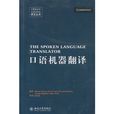《口語機器翻譯》是北京大學出版社2010年8月1日出版的圖書,作者是美國作家瑞諾爾、卡特爾、布伊隆。
基本介紹
- 書名:口語機器翻譯
- 又名: The Spoken Language Translator
- ISBN:9787301171561, 7301171560
- 頁數:337頁
- 出版社:北京大學出版社
- 出版時間:2010年8月1日
- 裝幀:平裝
- 開本:16
- 叢書名:計算語言學與語言科技原文叢書
作者簡介,內容簡介,目錄,
作者簡介
作者:(美國)瑞諾爾(Manny Rayner) (美國)卡特爾(David Carter) (美國)布伊隆(Pierrette Bouillon) 等 合著者:宗成慶
內容簡介
《口語機器翻譯》主要內容簡介:計算語言學研究濫觴於上世紀五六十年代的機器翻譯研究。中文的相關研究也幾乎同步開始,1960年起在柏克萊加州大學研究室,王士元、鄒嘉彥、C.Y.Dougherty等人已開始研究中英、中俄機器翻譯。他們的中文計算語言學研究,可說是與世界最尖端科技同步的。
目錄
導讀
Preface
Acknowledgements
Introduction
1.1 What This Book Is About
1.1.1 Why Do Spoken Language Translation?
1.1.2 What Are the Basic Problems?
1.1.3 What Is It Realistic to Attempt Today?
1.1.4 What Have We Achieved?
1.2 Overall System Architecture
1.3 An Illustrative Example
1.4 In Defence of Hand-Coded Grammars
1.5 Hybrid Transfer
1.5.1 The Need for Grammatical Knowledge
1.5.2 The Need for Preferences
1.6 Speech Processing
1.7 Corpora
Part 1 Language Processing and Corpora
Translation Using the Core Language Engine
2.1 Introduction: Multi-Engine Translation
2.2 Word-to-Word Translation
2.3 Quasi Logical Form
2.3.1 Introduction
2.3.2 Structure of QLF
2.3.3 QLF as a Transfer Formalism: Examples
2.3.4 Head-Head Relations in QLF
2.4 Unification Grammar and QLFs
2.4.1 The CLE Unification Grammar Formalism
2.4.2 Unification Grammar Example: French Noun Phrases
2.4.3 Example 2a: Clauses in Swedish
2.4.4 Example 2b: Relative Clauses in Swedish
2.5 Orthographic Analysis and the Lexicon
2.6 Transfer Rules
2.6.1 Pre- and Posttransfer
2.7 The QLF-Based Processing Path
2.7.1 Linguistic Analysis
2.7.2 Transfer and Transfer Preferences
2.7.3 Generation
2.8 Summary
Grammar Specialisation
3.1 Introduction
3.2 Explanation-Based Learning for Grammar
Specialisation
3.2.1 A Definition of Explanation-Based Learning
3.2.2 Explanation-Based Learning on Unification Grammars
3.2.3 Category Specialisation
3.2.4 Elaborate Cutting-Up Criteria
3.3 An LR Parsing Method for Specialised Grammars
3.3.1 Basic LR Parsing
3.3.2 Prefix Merging
3.3.3 Abstraction
3.4 Empirical Results
3.4.1 Experimental Setup
3.4.2 Discussion of Results
3.5 Conclusions
Choosing among Interpretations
4.1 Properties and Discriminants
4.2 Constituent Pruning
4.2.1 Discriminants for Pruning
4.2.2 Deciding Which Edges to Prune
4.2.3 Probability Estimates for Discriminants
4.2.4 Relation to Other Pruning Methods
4.3 Choosing among QLF Analyses
4.3.1 Analysis Choice: An Example
4.3.2 Further Advantages of a Discriminant Scheme .
4.3.3 Numerical Metrics
4.4 Choosing among Transferred QLFs
4.5 Choosing Paths in the Chart
The TreeBanker
5.1 Motivation
5.2 Representational Issues
5.3 Overview of the TreeBanker
5.4 The Supervised Training Process
5.4.1 Properties and Discriminants in Training
5.4.2 Additional Functionality
5.5 Training for Transfer Choice
5.6 Evaluation and Conclusions
Acquisition of Lexical Entries
6. 1 The Lexical Acquisition Tool, LexMake
6.2 Acquiring Word-to-Word Transfer Rules
6.3 Evaluation and Conclusions
Spelling and Morphology
7.1 Introduction
7.2 The Description Language
7.2.1 Morphophonology
7.2.2 Word Formation and Interfacing to Syntax
7.3 Compilation
7.3.1 Compiling Spelling Patterns
7.3.2 Representing Lexical Roots
7.3.3 Applying Obligatory Rules
7.3.4 Interword Rules
7.3.5 Timings
7.4 Some Examples
7.4.1 Multiple-Letter Spelling Changes
7.4.2 Using Features to Control Rule Application
7.4.3 Interword Spelling Changes
7.5 Debugging the Rules
……
Part 2 Linguistic Coverage
Part 3 Speech Processing

